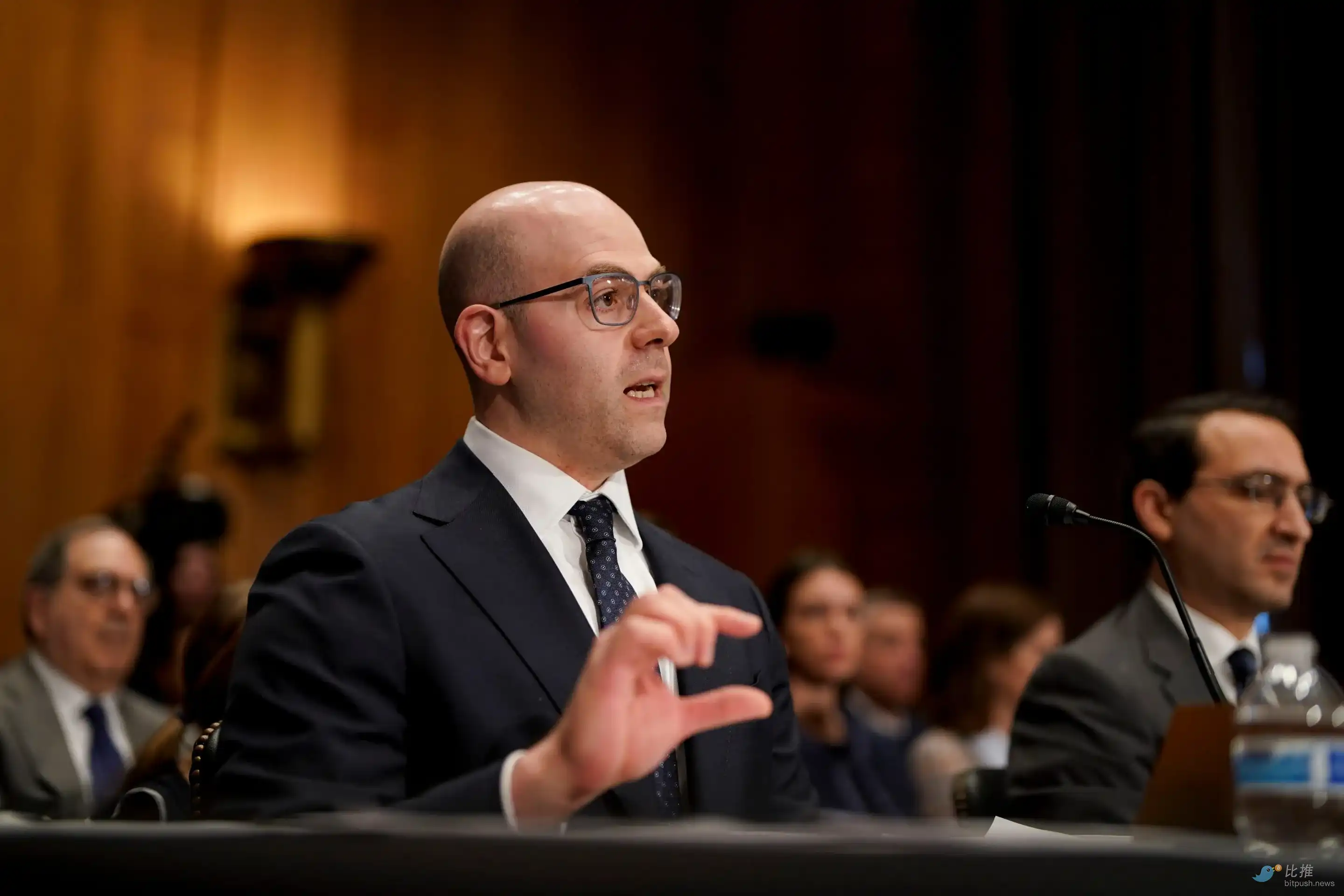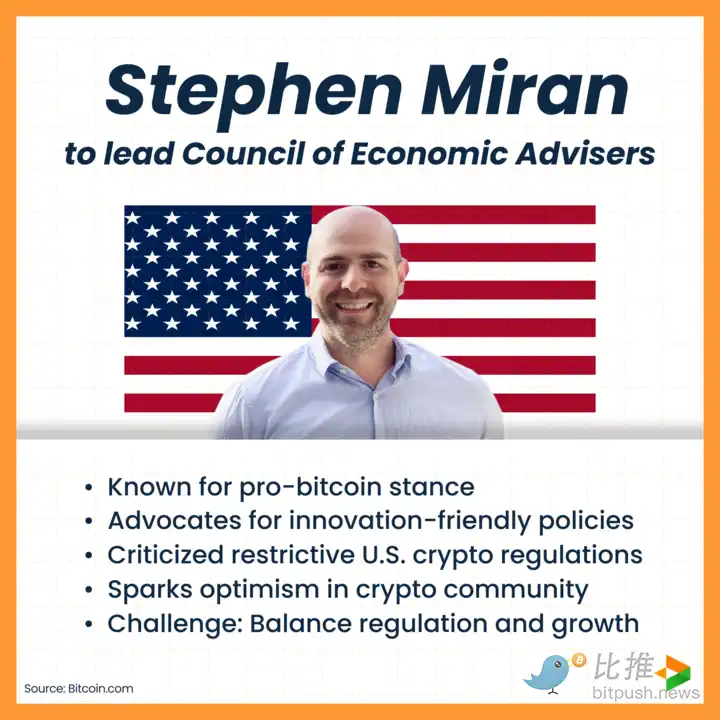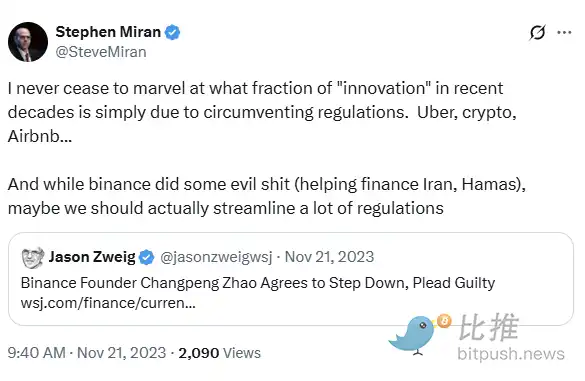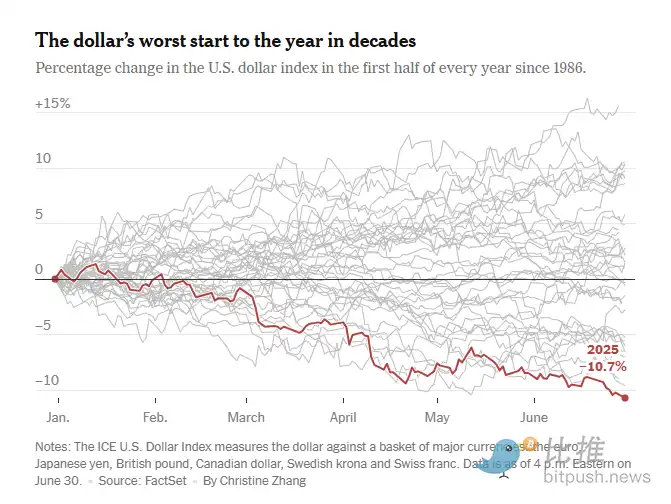Source: BitpushNews
On Thursday local time, just as Wall Street was nearing the close, President Trump announced on Truth Social that he appointed Stephen Miran, chairman of the White House Council of Economic Advisers (CEA), as a Federal Reserve governor to succeed the recently departed Adriana Kugler, with a term set until January 31, 2026.
According to Politico, the White House was not originally prepared to announce the successor arrangement for current Federal Reserve Chairman Powell. Miran's move serves both as a "gap filler" and as a "political signal."

Could this short "Fed audition" become an unexpected booster for the cryptocurrency industry? And at a time when the Fed's interest rate cut expectations and the trend of a weakening dollar intertwine, what does Trump's appointment of Miran signify?
Who is Stephen Miran? From Harvard to the White House's "friend of crypto"
Stephen Miran has an economics background from Harvard University and his career spans investment and policy fields. Before joining the Trump team, he served as a partner at Amherst Peak Advisors and as a senior strategist at Hudson Bay. Notably, Hudson Bay was deeply involved in debt trading after the bankruptcy of FTX—this cryptocurrency exchange declared bankruptcy at the end of 2022, and its founder Sam Bankman-Fried was sentenced to 25 years in prison in November 2023 for seven charges, including telecommunications fraud.
After joining Trump's camp in 2023, Miran quickly emerged, assuming the role of chairman of the White House Council of Economic Advisers (CEA) in March 2025. As a typical conservative economist, he firmly supports Trump's tariff policies and has publicly advocated for "lowering interest rates" and "reassessing the strong dollar policy" multiple times.
In the cryptocurrency field, Miran has demonstrated a rare open attitude. In December 2024, Stephen Miran, then chairman of the White House Council of Economic Advisers (CEA), was invited to participate in a famous financial podcast (Forward Guidance) where he discussed with host Joseph Wang (former New York Fed trader Fed Guy). In the second half of the program, Miran talked about the issues arising from the chaotic regulation of cryptocurrencies and stated:
"Perhaps we really should simplify a lot of regulations to allow innovative industries like cryptocurrency to truly take off."

At that time, U.S. cryptocurrency regulation was in chaos, with the SEC and CFTC unable to agree on token classification, and the Coinbase and Binance cases had yet to reach a conclusion. Miran's words were seen by many industry insiders as "the White House's first friendly signal." As CEA chairman, although his views do not hold legislative power, they have a "weather vane" significance in policy trends and regulatory discussions.

It is worth noting that Miran does not blindly support the cryptocurrency industry; he opposes the current reality of fragmented regulation, redundant approvals, and legal ambiguities, rather than regulation itself. He pointed out in the program:
· The current dispute between the SEC and CFTC over the attributes of crypto assets (securities vs. commodities) has severely impacted the compliance operation of innovative companies;
· The White House should promote a more coordinated regulatory framework, "so that entrepreneurs clearly know the compliance roadmap";
· The regulation truly beneficial to innovation is not "no regulation" but rather "clear rules and defined responsibilities."
This view, unlike traditional extremist views in crypto, is more aligned with the compliance-oriented crypto supporters, such as Coinbase CEO Brian Armstrong, who have long advocated for this path.
According to Coindesk, Miran has also privately participated in discussions regarding the ambiguity of the SEC and CFTC's token regulatory classification.
If Miran continues to publicly express a rationalization of cryptocurrency regulation during his tenure at the Fed, even if it does not directly influence policy-making, it could become an important catalyst for market sentiment, potentially accumulating voices for "potential candidate for the board" after 2026.
Federal Reserve Policy: The "entry" of a pro-rate cut advocate
"He is just here to warm the seat," commented Mark Spindel, author of the book (The Independence of the Federal Reserve), "He'll be gone after a few meetings."
Indeed, from a timing perspective, Miran will participate in at most three Federal Open Market Committee (FOMC) meetings—September, October, and December—with very limited structural impact on the annual interest rate path.
But this does not mean that Miran's voice is meaningless. In the second half of 2025, as the interest rate game becomes increasingly intense, a single vote in the council could cause market nerves to be on edge.
In terms of monetary policy, Miran is a typical Trump-era economist: supporting "American manufacturing," questioning the strong dollar strategy, and advocating for interest rate cuts to stimulate growth.
Between 2023 and 2024, he repeatedly pointed out in articles and public speeches that the Fed's sustained high interest rate policy is "extremely detrimental to American manufacturing and exports," calling for "more proactive monetary policy to complement industrial policy." He is also one of the few senior officials in the CEA who publicly stated that "a strong dollar is detrimental to national interests."
This resonates with Trump's continued criticism of Powell. Trump himself has repeatedly complained in public: "Powell has messed everything up, and high interest rates have made America lose its competitiveness." Miran academically endorses this view, reinforcing the White House's stance that "interest rates should serve growth objectives."
Although it is unlikely that Miran will change the Fed's interest rate path in the short term, if he advocates within the Fed that "inflation is under control, and we should focus on employment and investment," it will undoubtedly provide new policy imagination for the market. Especially against the backdrop of currently high U.S. Treasury rates and a weakening dollar index, the "return of interest rate cut expectations" is becoming a focal point for capital markets.
So far this year, the dollar's safe-haven status is facing unprecedented challenges. According to FactSet data, in the first half of 2025, the dollar index (DXY) has fallen by over 10%, marking the weakest performance for the first half of the year since 1973. The dollar, which used to strengthen during periods of financial market volatility, has now moved higher alongside long-term U.S. Treasury yields, displaying an "anomalous" characteristic typically seen in emerging markets.

Some analysts point out that Miran's challenge to the "strong dollar consensus" is forming the "prototype of a new consensus." He questioned in a paper: "Is a strong dollar really in the national interest? Should we consider a more flexible exchange rate mechanism for export-oriented manufacturing?" Such views are gradually gaining ground within the Trump administration.
How should the crypto market view Miran's entry?
For the cryptocurrency industry, Miran's temporary rise might mean:
The policy atmosphere is warming: His stance reinforces the White House's interest in cryptocurrency and may also promote clearer regulatory integration.
Risk asset sentiment heats up: If he promotes interest rate cuts or guides expectations for easing, risk assets like BTC and ETH will directly benefit.
The trend of the dollar affects stablecoins and cross-border payment paths: a weak dollar strategy will enhance the attractiveness of crypto assets in international payments.
Although Miran is not a legislator and cannot single-handedly change the Fed's course, his views are already shaping the macro sentiment framework for the second half of 2025. This policy-maker with an academic background may have a much larger stage than just these five short months.
Reference: · MarketWatch: Trump taps Miran for Fed seat · Politico: Trump picks economic adviser Miran for Fed post · Forward Guidance Podcast (2024.12) · FactSet, ICE Dollar Index


